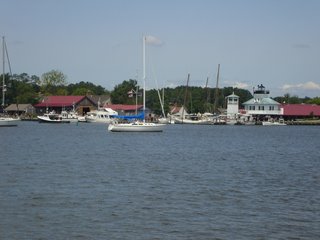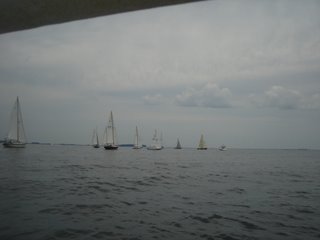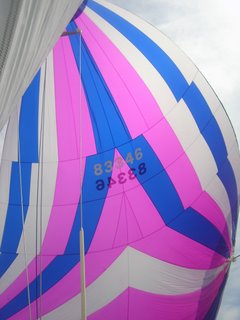Racing with the Herring Island Fleet
 Today I raced on the boat I've been crewing on from time to time over the last 3 years, Penniless, with the Herring Island Sailing Fleet (HISF) Saturday series. This was our first time racing spinnaker this year, and a "dry run" for the Solomons Race and Screwpile Regatta that happens next weekend and part of the following week. This is one of the classic Chesapeake "ocean" races, and the skipper and owner were trying to get the boat and crew both shaken down ahead of time so things would go smoothly on the overnight race and the 3 days of day races that follow it. I haven't done the Solomons/Screwpile yet, although I did race the Governor's Cup overnight race from Annapolis to St. Mary's City in 1998 on a different boat. Penniless is a C & C 30 Mk I (my last boat, Aurelia, was a C & C 30 Mk II and you might think they would be quite similar, but in fact they are totally different.)
Today I raced on the boat I've been crewing on from time to time over the last 3 years, Penniless, with the Herring Island Sailing Fleet (HISF) Saturday series. This was our first time racing spinnaker this year, and a "dry run" for the Solomons Race and Screwpile Regatta that happens next weekend and part of the following week. This is one of the classic Chesapeake "ocean" races, and the skipper and owner were trying to get the boat and crew both shaken down ahead of time so things would go smoothly on the overnight race and the 3 days of day races that follow it. I haven't done the Solomons/Screwpile yet, although I did race the Governor's Cup overnight race from Annapolis to St. Mary's City in 1998 on a different boat. Penniless is a C & C 30 Mk I (my last boat, Aurelia, was a C & C 30 Mk II and you might think they would be quite similar, but in fact they are totally different.)We left the harbor at St. Michaels (first photo) at about 1100. Weather was quite comfortable for July in Maryland, with moderate humidity and temperatures in the low 80's. Alas, there was a distinct lack of wind; the forecast said 5-10 knots, but a lot of the time it was lighter.

The Race Committee assigned us a 7 mile course, which didn't sound very long, but the skipper knew better: he immediately said that it was too long for this amount of wind. Including tacking, of course, the actual distance sailed would be considerably farther than the rhumb line distance of 7 miles, and at the start there was so little wind that many of theboats couldn't even get steerage way, including our boat, never that great in very light conditions. In Photo 2, you can see the sails of the other boats hanging almost lifeless, and the oily flatness of the water.
We were unable to get across the starting line until many minutes after the gun, and were I think either last or second to last to start. This was because in the prestart maneuvering we didn't have enough headway to tack, and had to jibe around to head for the line. For a while after starting we seemed barely able to move, but gradually a little wind filled in and we moved away from Herring Island, a submerged shoal separating the Miles from the Wye Rivers, and up to the entrance to the Wye where the first mark of our course was. On this windward leg Penniless showed some of her most endearing qualities: if the wind is over 5 knots she sails closer to the wind than most boats and as fast as others of similar size. We had a recently recut genoa that seemed to allow us to point higher than before, and our crew work was very good. We moved up several places, aided by other boats falling into holes with no wind that were in various locations around the course.

Rounding that mark in mid-pack, we headed for Tilghman Point, several miles away and almost dead to windward, after a short jog over to the west side of the river to get around the shallow spot where the island used to be. (On this short reaching leg we actually hoisted the spinnaker and it did fill, although I doubt it helped us that much).
On the second windward leg to Tilghman Point the wind oscillated wildly from about 6 knots to zero, with shifts of 40 degrees and more. Maybe it was just a crapshoot, but we managed to move up through the fleet to challenge the leaders, and actually rounded in third place. Then we hoisted the spinnaker again, and I took Photo 3 to show it actually drawing rather nicely.
I trimmed main most of the time, the thing I usually do on racing boats ever since Hawaii. I also manned the halyards, hoisting and lowering the spinnaker and genoa, because the winches and sheet stoppers for those halyards are on the aft edge of the cabin top immediately forward of the bridge deck traveller, so right by the mainsheet trimmer's station. I hope I'll be doing the same jobs in next week's regatta or the practice won't help.
It must be that the wind increased very much on this downwind leg, because as it continued it became much easier to keep the sails working. By the time we were approaching the buoy at the end of this leg, it was 1530, and for some reason it never occurred to anyone on board that the race had been going on for a long time and management might be thinking about shortening it. We did have the radio on, listening to the frequency the race committee was supposed to be using. They never talked. So, approaching this buoy we doused the spinnaker when there was still a few boatlengths to go because we had to head up beyond the best angle for the spinnaker to round. It was only after the jib was up and the spinnaker was being stuffed below that someone realized the other boats were not steering for the buoy, and there was a powerboat anchored on the "wrong" side of the buoy that looked just like the committee boat...yes, a finish line, and we didn't have to head up at all! So, we finished in 4th place by about 10 seconds. Had we kept the spinnaker up we would certainly have crossed the line in third place. About 12 boats were in the race, and alas, my hope that we might have saved our time on handicap on the other boat were dashed when the skipper explained that we rated the same.
However, except for that little goof we had quite good sail trim and boat handling and didn't make any major mistakes. We even jibed the spinnaker twice! This is the kind of race that helps you do well in the standings of a series. I hope we can do as well at Solomons!

1 Comments:
Good luck! Nice photos! :-)
Post a Comment
<< Home